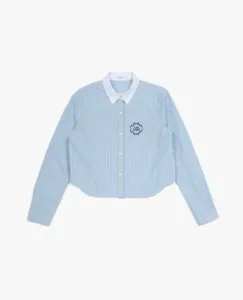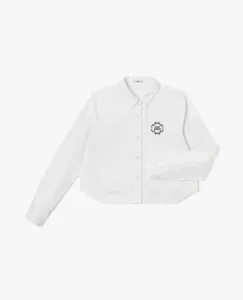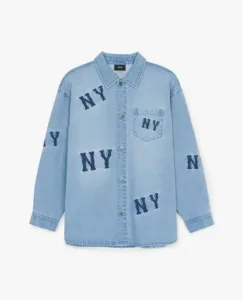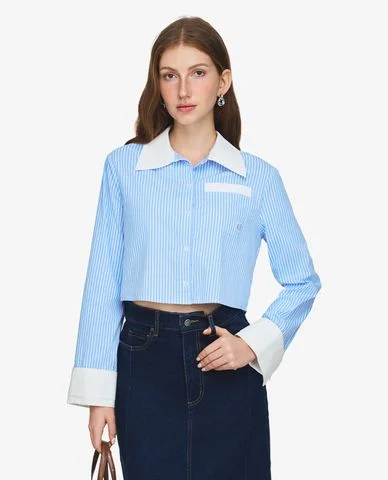news
The Versatility of the Women’s Shirt: From Formal Blouse to Casual Icon
The women’s shirt, in its myriad forms, is one of the most versatile and essential garments in the modern wardrobe. Its journey from a simple, unadorned undergarment to a centerpiece of style is a fascinating story that mirrors the evolution of social norms and sartorial tastes. This essay will take a deep dive into the world of women’s shirts, exploring their historical origins, the different types that exist today, the fabrics that define them, and the role they play in shaping a woman’s personal style.
Historically, the shirt was a strictly functional piece of clothing. In the Middle Ages, it was a simple linen or cotton tunic worn underneath more expensive outer garments to protect them from the body. It was rarely seen in public and was a symbol of a woman’s inner cleanliness. Over time, as dress codes became more formalized, the shirt began to emerge from the shadows, with its collars and cuffs becoming visible elements of an outfit. By the 18th and 19th centuries, a starched, white shirt became a powerful symbol of status and wealth, indicating that a woman did not engage in manual labor and could afford to have her shirts cleaned regularly. The more elaborate the frills and ruffles, the higher the woman’s social standing.

The 20th century marked the beginning of a revolution for the women’s shirt. The invention of the detachable collar in the late 19th century made it easier to clean, but it was the widespread adoption of the soft, attached collar that truly changed the game. This innovation, popularized by brands like Brooks Brothers, made the shirt more comfortable and accessible for everyday wear. The subsequent introduction of the button-down collar, originally designed to keep polo players’ collars from flapping in the wind, further cemented the shirt’s status as a versatile and stylish garment.
The Dress Blouse: The Cornerstone of Formality
The dress blouse remains the cornerstone of formal and business attire. It is a garment defined by its elegant simplicity, tailored fit, and sophisticated details. Dress blouses are typically made from fine, flowy fabrics that lend them a polished look and a smooth feel. The choice of fabric is crucial, as each type offers a different texture and level of formality.
- Silk: Silk is a luxurious and timeless fabric that is known for its soft, smooth texture and its beautiful drape. A silk blouse is a classic and elegant choice for a formal or business setting, and it can be dressed up with a blazer or a skirt.
- Rayon: Rayon is a semi-synthetic fabric that is known for its soft, fluid feel and its ability to mimic the look of silk. A rayon blouse is a great alternative to silk, as it is more affordable and easier to care for.
- Cotton: Cotton is a versatile and breathable fabric that is perfect for a casual or business-casual setting. A cotton blouse can be worn with a skirt or trousers, and it can be dressed up with a blazer or a cardigan.
- Polyester: Polyester is a durable and wrinkle-resistant fabric that is perfect for travel. A polyester blouse is a great alternative to silk or rayon, as it is more affordable and easier to care for.
The style of the collar is also a key detail that can change the look of a dress blouse. The point collar is the most common and traditional style, with a narrow spread between the points. The spread collar has a wider distance between the points and is often considered more modern and fashionable. The cutaway collar has an extremely wide spread and is designed to be worn with a tie and a large knot.

The Casual Shirt: A Canvas for Self-Expression
While the dress blouse dominates the formal sphere, the casual shirt is where women’s fashion truly finds its freedom. This category is vast and diverse, offering a style for every occasion and personality.
- The T-Shirt: As a modern icon, the T-shirt is the epitome of casual comfort. It is a simple, collarless garment made from a soft knit fabric, typically cotton. Its versatility is unparalleled; it can be worn as a stand-alone top, or layered under a jacket, a shacket, or a cardigan. Graphic T-shirts, in particular, serve as a canvas for personal expression, with designs ranging from band logos to artistic prints.
- The Tank Top: The tank top is a simple, sleeveless top that is perfect for warmer weather. It can be worn on its own for a relaxed, casual look, or it can be layered under a blazer or a cardigan for a more polished aesthetic.
- The Tunic: The tunic is a loose-fitting top that is perfect for a relaxed and bohemian look. It can be worn with leggings or skinny jeans, and it is a great choice for a casual day out or a weekend trip.
- The Crop Top: The crop top is a rebellious and trendy style that is perfect for a night out or a casual day. It is a top that is cut short to expose the midriff, and it can be styled with high-waisted jeans or skirts.
- The Button-Down Shirt: The button-down shirt, once a purely masculine garment, has been beautifully adapted for women, offering a sleek, minimalist look that is both professional and chic. It can be worn buttoned up, half-tucked, or oversized, demonstrating its remarkable versatility.
The Importance of Fabric and Fit
The modern woman understands that the quality of a shirt is determined by its fit and its fabric. A well-fitting shirt is the key to looking polished and confident, regardless of the occasion. Today, brands offer a wide range of fits, from slim-fit for a more modern, tailored look to classic-fit for a more traditional silhouette. The oversized fit is designed to give a woman a relaxed and comfortable look, while the cropped fit is designed to expose the midriff.
The choice of fabric is also paramount. While cotton remains the king of shirt fabrics due to its softness and breathability, new materials and blends have emerged to offer added benefits. Linen is a popular choice for summer shirts due to its lightweight and breathable properties. It has a natural, relaxed look that is perfect for casual settings. For performance, fabrics like polyester and nylon blends are used to create shirts that are moisture-wicking, quick-drying, and wrinkle-resistant. These are a great option for the active woman or for travel.

Styling the Shirt
The shirt is the most versatile garment in a woman’s wardrobe, and the way it is styled can completely change the look of an outfit. A simple dress blouse can be worn with a skirt for a formal event, or with trousers and a blazer for a smart casual look. A denim shirt can be paired with black jeans for a monochromatic look or with khaki chinos for a more traditional feel. A T-shirt can be worn on its own for a relaxed, effortless look, or it can be layered under a blazer or a jacket to add a bit of polish.
The shirt’s adaptability makes it a fundamental part of any woman’s personal style. It can be a symbol of formality, a canvas for self-expression, or a comfortable everyday garment. The modern woman’s wardrobe is a testament to this versatility, holding a diverse collection of shirts that can be mixed and matched to create a look for every occasion.
In conclusion, the women’s shirt has come a long way from its humble origins as a simple undergarment. It has evolved into a diverse and versatile piece of clothing, with a style, fabric, and fit for every woman. The modern shirt is not just about covering the body; it is about self-expression, comfort, and confidence. Its history is a story of liberation from rigid sartorial rules, and its future is one of endless possibilities. The shirt, in all its forms, remains the foundation of the female wardrobe, a timeless classic that continues to adapt to the changing tastes and lifestyles of the modern woman.

